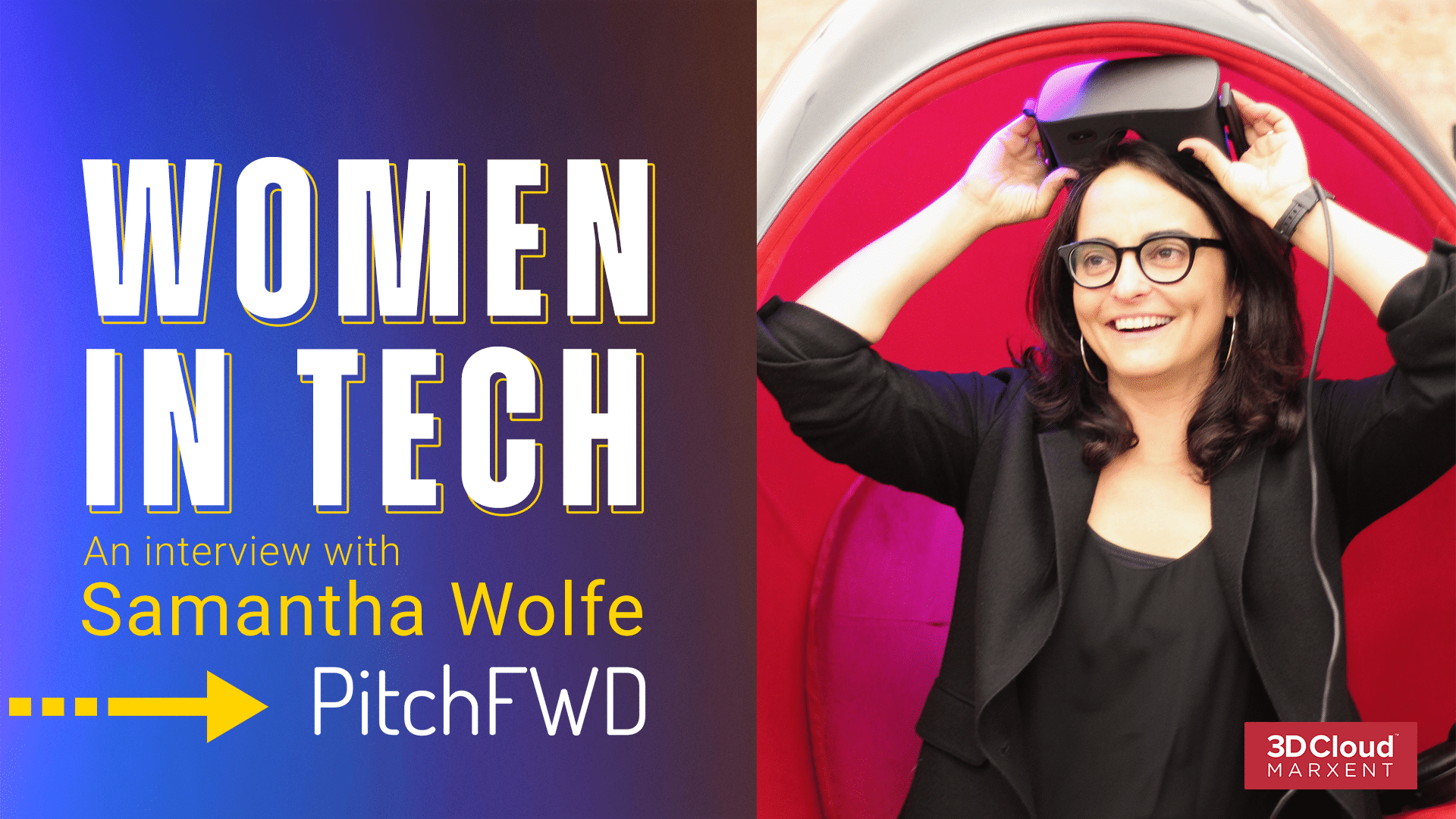
In honor of Women’s History Month, we are speaking to Women in Tech to amplify the stories and pathways of women in technology across the industry. In 2020, only 31% of IT employees were women, according to Gartner Research. We interviewed women in the tech industry that we admire and we’d like to introduce you! So, grab yourself a coffee, pull up a chair, and meet Samantha G. Wolfe from PitchFWD.
Hi! I’m Samantha G. Wolfe, I am the Founder of PitchFWD, a strategic branding, and marketing consultancy for emerging tech companies. Effectively, we operate before the chasm, if you understand the Geoffrey Moore reference. I am an Adjunct Professor at NYU’s Steinhardt School where I teach classes that I developed including ‘The Business of Virtual Reality and Augmented Reality and ‘The Marketing of Innovation’ and a new class called ‘Avatars & Virtual Beings’ this coming fall. I also co-authored the book, “Marketing New Realities,” contributing a chapter focused on “Augmented Reality & Brands” to Charlie Fink’s book “Convergence,” and I’m working on a new (to be announced) book about the metaverse.
What steps did you take to reach your level of success?
I have a few things that I’ve tried to do consistently since I joined the emerging tech industry. I have networked with people in the industry and read about new innovations since Day 1. I love to meet new people, hear their perspectives, and understand their visions of the future. As innovation can happen at any time, I always have something to learn, which makes it exciting. I also try to support the industry wherever I can, whether it be connecting two people or companies, joining a new podcast, speaking or judging at events, mentoring start-ups, or trying to help people outside of the industry understand the value of new technologies. I also have fun with my Twitter account and provoke discussions around innovation tech that hopefully get people to think and laugh at the same time. One time I put up a post similar to: “If you were forced to choose only one avatar and only one for every situation, would you pick a hyper-realistic being or a cartoonish version?” It got a lot of people debating the value of each and realizing that we likely will want multiple personal avatars in the future.
What has been your biggest challenge as a Founder of PitchFWD?
My biggest challenge has been getting companies in the tech space to understand the value of branding and marketing strategy. They tend to believe that if the technology is good enough it will sell itself. I spent an entire class this semester proving that perspective is entirely wrong and how branding and marketing strategy can make a huge difference in the success of an emerging tech. When I work with a company, the executives start to say that their pitches, presentations, and meetings went much better and that people understand what their technology is and its value – and that’s only just the start of our work at PitchFWD.
What has been your biggest success in your current role?
Besides writing books and the talks I’ve done, I’ve appreciated more than anything the acceptance I’ve received from the developer community. Although they usually dislike and mistrust marketing, creators in the space have come to understand that my job is all about supporting their efforts and helping them to succeed. That has led me to be a part of SIGGRAPH, the MIT Reality Hackathon, and other developer-focused events based on their referrals.
How do you differentiate yourself?
There was hardly anyone in branding and marketing in VR and AR when I started. People said it was too soon, that it wasn’t needed. I disagreed and decided that I’d help to guide the industry with the tools I have. For instance, I know I can explain very technical topics to people who don’t know much about technology. So when I heard many people get confused about defining the metaverse, I inserted myself in the conversation. Sometimes I feel like I’m acting like an industry-wide CMO, whose goal is the accelerated adoption of these new technologies.
How do you move forward with differing opinions?
My work with CEOs and the C-Suite is amazing, but it comes with its difficulties. Many executives in the space are coders and developers. They can create the future, but that doesn’t mean that they can explain the value of what they are making. Their innovation’s value seems incredibly obvious to them, although their potential clients or customers do not see it at all. I have to spend a lot of time discussing with management why there is a need to change their positioning to showcase their differentiation, and how less advanced technologies are winning business because of this lack of understanding. Most executives would prefer to get right to the tactics: put out a press release, schedule an interview, buy an ad and sell now, write a thought leadership piece. But this critical – albeit sometimes painful for the executive – strategic step impacts the success of everything else. I never want a potential customer’s lack of understanding of technology to be why a company loses business.
What are your tips for thriving both personally and professionally?
I actively seek out innovators in the space. Yes, I would love the opportunity to work with them, but, more importantly, I genuinely am thrilled and want to support what they do. So, I will reach out via LinkedIn or Twitter, even if I have never met them. For example, I had followed and loved Marxent for a while. So I contacted the head of marketing, Sonia Schechter, and said she needed to come to my class. I have been known to jump up and down with excitement when I meet someone for the first time. Just ask Curtis Hickman (The Void), Martina Welkoff (WXR), Chad Evans (NBA), or Anne Ahola Ward (CircleClick), all of who lived through it. In the past couple of years, my class has enabled me to invite executives from all over the world to speak via Zoom to my class. Next week, I cannot believe that I have Raja Rajamannar, the CMO of Mastercard coming. I used his ‘Quantum Marketing’ book this semester. So I contacted him on LinkedIn, and he agreed to drop in. It’s like I get to create a mini, 14-week conference for my students and myself each semester. I’ve had easily over 100 if not 150 of my favorite people join. It’s been an amazing experience.
With the metaverse, the shift is going to be massive, like that of the internet or mobile computing.”
Where do you see the future of the metaverse?
Often I advise executives that they never should say that their technologies can do anything for anyone anywhere under any circumstances. But, with the metaverse, the shift is going to be massive, like that of the internet or mobile computing. I covered over 20 industries in my ‘Business of VR & AR’ class, and each one of them will benefit from the metaverse. I love to play a ‘name an industry, any industry’ kind of game with people outside of XR. I then can come up with business applications on the spot that get them intrigued and inspired to learn more. It’s an amazing space to be in right now.
What would you say to people/companies still hesitant about investing in virtual reality?
When it comes to virtual reality, I think you need to spend a little time understanding what the technology is and the potential value of it – without looking at existing use cases or budgets at first. If you fundamentally understand what it’s trying to do, then you can begin to brainstorm based on the potential value of what you could create – even if you don’t know how to develop it yourself. Now maybe the first thing your company does is a relatively small test with existing assets, but this brainstorming process will enable you to understand the end goal and plan ahead towards that.
Any advice for the future generation?
I tell anyone who wants career advice to learn how to code (of course) or to learn how to manage or protect data. The metaverse will have more data than we can even imagine now, so there will be a lot of job opportunities. But, for any college student who has any inkling towards marketing and emerging tech, I warn them of the tough road ahead, but I also will help them get a job. It’s rewarding to think that I’ve helped the potential future leaders of the tech industry find an internship or their first job.
Thank you for your time, Samantha. We really appreciate you taking the time to share your personal and professional experiences. We can’t wait to see all the opportunities that will come with you and your future of the Metaverse. Learn more about Samantha and her work at PitchFWD here.
Keep an eye out for the next Women in Tech feature and if you would like to take part, shoot us a follow on LinkedIn.













